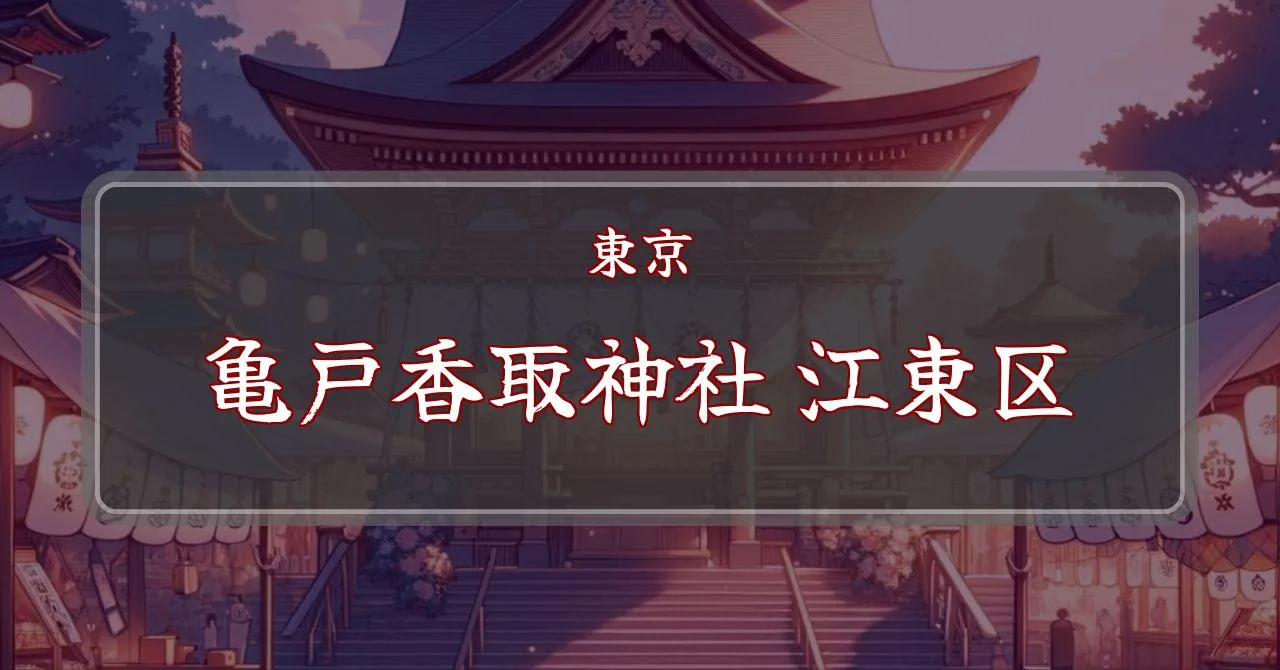亀戸香取神社勝矢祭2025:勇壮な武者行列で勝利を祈願!
イベントの概要
東京都江東区の亀戸香取神社で、2025年5月5日(月・祝)に開催される「勝矢祭」は、平安時代から続く歴史深いお祭りです。 「スポーツ振興の神」として知られる亀戸香取神社では、子どもの日に、古くから弓矢を奉納する儀式が行われてきました。その起源は、940年の平将門の乱に遡ります。将門討伐で勝利を収めた藤原秀郷が、戦勝祈願をしたこの神社に「勝矢」と名付けられた矢を奉納したのが始まりと言われています。
勝矢祭のハイライトは、なんといっても勇壮な武者行列です!鎧兜や陣羽織、裃を身につけた氏子たち約200名が、亀戸香取神社の兼務社である亀出神社(江東区大島3-31-15)から出発。 「エイ、エイ、オー」の力強い勝鬨を挙げながら、亀戸駅前十三間通りなどを経て、約2kmの道のりを練り歩きます。 沿道には多くの見物客が詰めかけ、その勇ましい姿に見入ります。 午後3時頃、亀戸香取神社に到着すると、本殿で勝矢の奉納の儀式が厳かに執り行われます。 亀戸駅周辺は歩行者天国となるため、安全に、そしてじっくりと武者行列をご覧いただけます。
1000年以上の歴史を持つこの神事は、勝利を願う人々にとって特別な意味を持ちます。スポーツ大会や試合の勝利を祈願する参拝者も多く訪れる亀戸香取神社で、歴史と伝統に触れ、活気に満ちた勝矢祭を体感してみませんか?
開催日時:2025年5月5日(月・祝)13:00~(武者行列出発)15:00~(亀戸香取神社到着、本殿祭)
開催場所:亀出神社(江東区大島3-31-15)→亀戸駅前十三間通りほか→亀戸香取神社(江東区亀戸3-57-22)
アクセス:JR総武線・東武亀戸線「亀戸駅」北口徒歩10分
お問い合わせ先:亀戸香取神社 03-3684-2813
関連URL:https://www.kameido-katori.com/
基本情報
- 開催日:2025年5月5日(月・祝)
- 開催時間:
- 13:00~:武者行列(亀出神社発)
- 15:00~:亀戸香取神社到着、本殿祭
- 住所・開催場所:
- 出発地点:亀出神社(江東区大島3-31-15)
- 武者行列ルート:亀戸駅前十三間通りなど
- 到着地点・本殿祭:亀戸香取神社(江東区亀戸3-57-22)
- アクセス:JR総武線・東武亀戸線「亀戸駅」北口より徒歩約10分
- お問い合わせ先:亀戸香取神社 03-3684-2813
主なイベント
亀戸香取神社勝矢祭の最大の見どころは、なんといっても勇壮な武者行列です。平安時代から続く歴史と伝統を受け継ぎ、現代に蘇るこの行列は、地域住民の結束と、スポーツ振興の神としての亀戸香取神社の威厳を象徴する一大イベントです。 約200名もの参加者が、鎧兜や陣羽織、裃などの装束を身につけ、力強い「エイ、エイ、オー」の掛け声とともに、亀戸の街を練り歩きます。その迫力ある姿は、見る者の心を掴んで離しません。
武者行列
武者行列は、亀戸香取神社の兼務社である亀出神社から出発します。 約2kmの道のりを、約2時間かけて練り歩きます。行列には、氏子だけでなく、地元の小学生の鼓笛隊なども参加し、華やかさを添えます。 行列は、亀戸駅前十三間通りなど、亀戸の主要な通りを通過するため、多くの見物客が沿道に集まり、熱気に包まれた雰囲気を味わえます。 行列の進行中は、参加者たちが「エイ、エイ、オー」と力強い掛け声を上げ続けるため、その迫力と一体感は圧巻です。 亀戸駅周辺は歩行者天国となるため、安全に、そしてじっくりと武者行列をご覧いただけます。
- 参加者:氏子、地元小学生の鼓笛隊など、約200名
- ルート:亀出神社→亀戸駅前十三間通りなど→亀戸香取神社
- 所要時間:約2時間
- 見どころ:鎧兜や陣羽織、裃などの装束、力強い掛け声「エイ、エイ、オー」
本殿祭
武者行列が亀戸香取神社に到着すると、本殿において勝矢の奉納を伴う神事が執り行われます。 これは、平安時代の平将門の乱の際に、藤原秀郷が戦勝祈願をし、乱平定後に奉納した「勝矢」に由来する、由緒ある儀式です。 神事の厳粛な雰囲気と、それまでの武者行列の賑やかさの対比が、このお祭りの独特の魅力となっています。 本殿前での最後の勝鬨は、祭りのクライマックスを飾る、忘れられない瞬間となるでしょう。
- 内容:勝矢の奉納を伴う神事
- 場所:亀戸香取神社本殿
- 見どころ:厳粛な神事の雰囲気、歴史と伝統を感じさせる儀式
アクセス方法
亀戸香取神社勝矢祭は、東京都江東区で開催されます。アクセス方法は主に公共交通機関が便利です。
- 電車:JR総武線・東武亀戸線「亀戸駅」北口から徒歩約10分。駅からの道順は比較的分かりやすく、明治通り沿いを北上すれば神社の鳥居が見えてきます。
その他の情報
勝矢祭は、屋外で開催されるイベントです。天候に左右されるため、当日の服装や持ち物には注意が必要です。 武者行列は、主に道路上で行われますので、歩きやすい靴を履いて参加することをお勧めします。また、日差しが強い場合は、帽子や日焼け止めクリームなどもご用意ください。水分補給も忘れずに行いましょう。小さなお子様と参加される場合は、迷子防止策も忘れずに行ってください。
- 服装:歩きやすい服装、帽子
- 持ち物:飲み物、日焼け止め、タオル
- 天候:雨天決行の場合が多いですが、公式ホームページで最新情報を確認することをお勧めします。
公式情報
亀戸香取神社の公式ウェブサイトで、勝矢祭に関する最新情報や詳細を確認できます。
- https://www.kameido-katori.com/
- 問い合わせ先:亀戸香取神社 03-3684-2813




